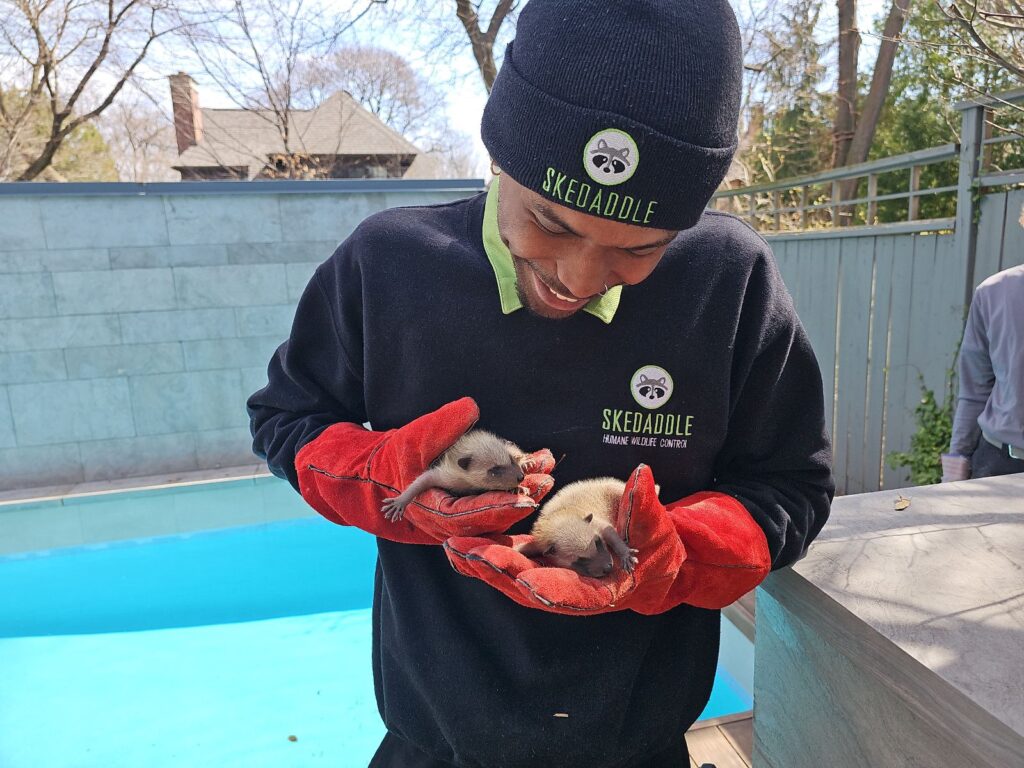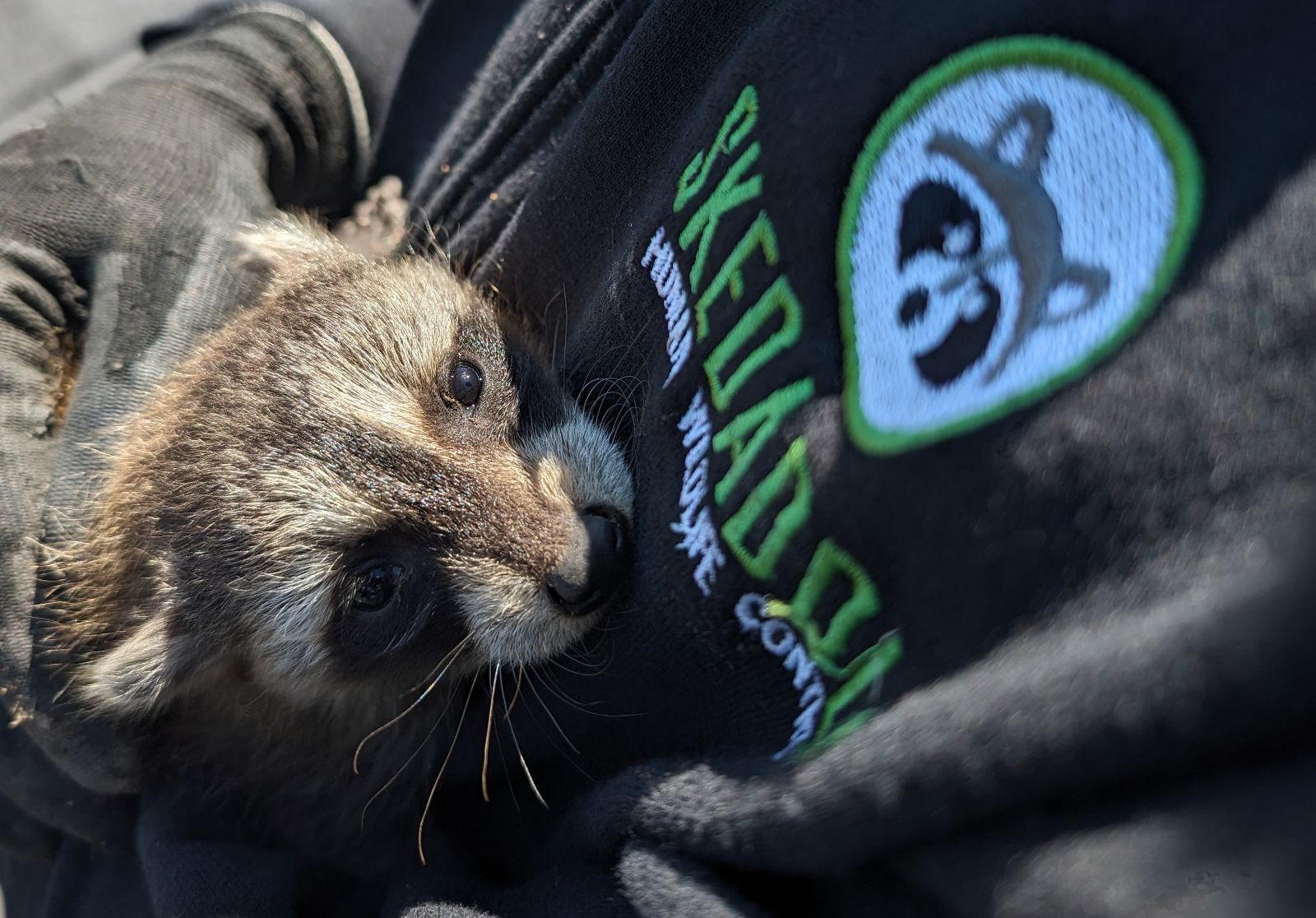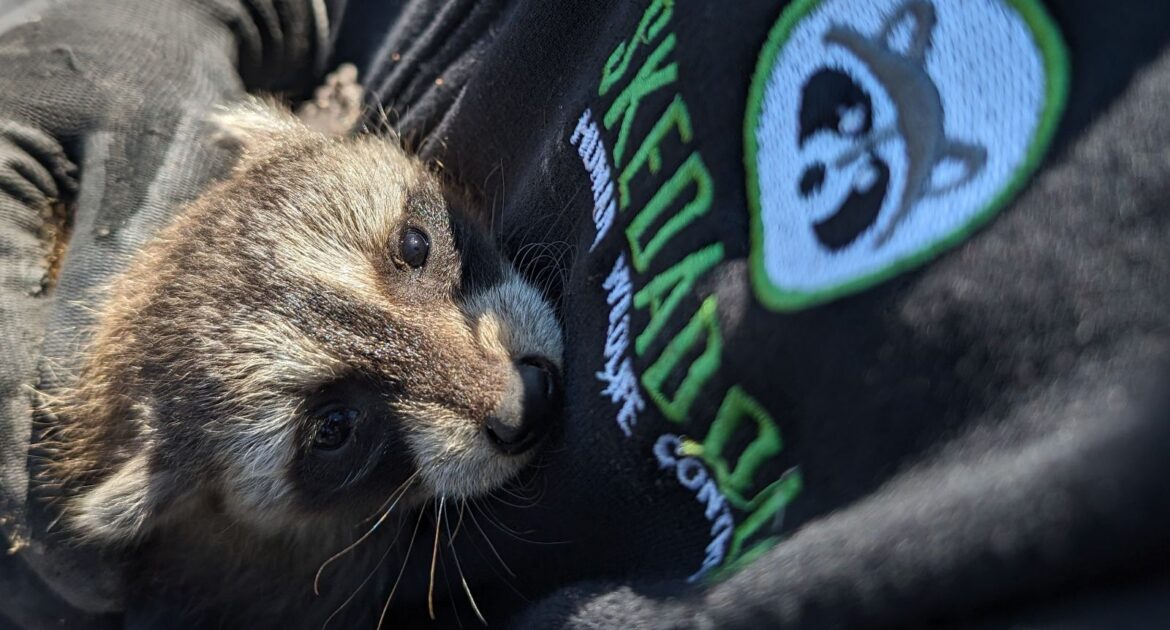Raccoons, famously known as the masked adventurers of the night, exhibit an extraordinary ability to adapt to various habitats, from dense forests to bustling city streets. Their increasing presence in urban areas, particularly in Toronto, poses unique challenges and fascinating insights into wildlife adaptation and cohabitation. These clever creatures have moved from their natural forest dwellings to find new shelter preferences within our backyards, gardens, and unfortunately, our attics, turning “raccoon in the attic” into a common homeowner concern.
At Skedaddle Humane Wildlife Control, we specialize in addressing the dilemma of how to get rid of raccoons in your attic and offer local wildlife removal services. Our expertise lies not only in humane wildlife control but also in understanding the behaviour and habitat preferences of raccoons, allowing us to offer an insightful guide to raccoon habitat and shelter preferences. Through this exploration, we aim to shed light on why these animals are drawn to urban settings like Toronto, how they choose their shelters, and the most effective ways to ensure that your attic does not become their next home.
Raccoon Behaviour and Natural Habitats
Raccoons are highly adaptable animals with a preference for habitats that offer easy access to food and water. Typically, these environments include wooded areas close to water sources, such as rivers or streams, where they can find an abundance of food. Their natural shelter options often consist of hollow trees, ground burrows, and dense underbrush; however, as they’ve grown more accustomed to urban life, their choices have expanded.
In terms of behaviour, they are primarily nocturnal and spend most of the night foraging for food. Their diet in the wild is varied and opportunistic, including fruits, nuts, insects, and small aquatic creatures. This versatility in diet has made their adaptation to city life particularly successful. Raccoons are known for their intelligence and curiosity, traits that lead them to explore and adapt to environments efficiently, always in search of food and safe havens.
Our understanding of these preferences and behaviours is vital to managing encounters with them, especially in urban areas where they are often considered a nuisance. This knowledge informs our strategies for humane intervention and helps us educate the community on coexisting with these fascinating creatures. By appreciating the natural inclinations of raccoons, including their search for food and shelter, we can create environments that are less attractive to them, reducing the likelihood of them turning our attics into their homes. This not only aids in maintaining the balance between urban and wildlife spaces but also minimizes the need for our intervention.
Raccoons in Urban Settings
The remarkable adaptability of raccoons to urban environments highlights their ability to find and utilize resources in cities. These intelligent creatures are attracted to urban settings that mimic their natural habitats in important ways, particularly those that offer abundant food sources and potential nesting sites. They have shown a special affinity for residential areas, where human activity provides a constant supply of food, whether through unsecured garbage cans, pet food left outdoors, or even compost bins.
Why Residential Areas?
Residential areas offer raccoons a unique advantage, combining easy access to food with ample opportunities for shelter. The warmth of homes, especially the unused spaces like garages and lofts, poses an irresistible appeal for these animals as nesting sites. Furthermore, the human-induced changes in the landscape provide them with various hiding spots away from predators, enhancing their survival rates in urban spaces.
Raccoons’ preference for living close to humans stems from their opportunistic feeding habits. The waste humans produce, intentionally or otherwise, becomes a treasure trove of meals for these animals, driving them to explore and settle in areas of high human activity. Understanding this dynamic is crucial for effectively managing our coexistence with raccoons and ensuring that our homes and neighbourhoods remain safe and welcoming for all inhabitants.
Recognizing A Raccoon Infestation
Attics offer an unsurpassed sanctuary for raccoons, especially during the critical breeding seasons when they seek secure and secluded areas to raise their young. The primary factors that draw these animals to such spaces include the warmth and protection from predators provided by these human-made structures. During winters and early springs, the cozy and insulated environment of an attic becomes a perfect nesting site, contrary to the harsh outdoor conditions.
Key Signs of Raccoon Presence
- Nocturnal Noises: One of the most unmistakable signs is the sound of activity during the night. These can include scratching, walking, or vocal sounds made by raccoons as they move around or communicate with their young.
- Roof Damage: They are excellent climbers and can cause noticeable damage to the roof as they make their way in and out. Look out for torn shingles or damaged roof vents.
- Unusual Droppings: Finding droppings near your home or in the attic space itself is a clear indicator. These droppings can pose health risks and should prompt an immediate check.
By staying vigilant and recognizing these signs early, homeowners can take timely steps to address the situation, preventing a small issue from becoming a significant concern. Utilizing this knowledge enables us to maintain our living spaces safely and comfortably, coexisting with nature in a way that respects the needs of all wildlife.

Risks Associated with Raccoons in the Attic
Having unwelcome visitors in your attic space, such as raccoons, can pose several risks to both homeowners and their properties. This section aims to provide an overview of these potential hazards, ensuring you’re well-informed of the implications of such infestations.
Structural Damage
The first significant concern is the structural integrity of your home. Raccoons, with their strong and dexterous paws, have the capability to tear off roof shingles, dismantle vents, or chew through wiring in their quest for entry and comfortable nesting. Such activities not only compromise the security of your attic but can lead to costly repairs and even increased fire hazards due to damaged electrical wiring.
Health Risks
Another alarming risk comes from the health implications of their droppings. Their waste may contain harmful pathogens like raccoon roundworm eggs, which can pose serious health risks to humans if not handled properly. The accumulation of feces and urine can also create unpleasant odours and mould growth, further impacting the living conditions within your home.
Aggression and Safety
The potential for raccoons to become aggressive, especially when they feel cornered or threatened, is a lesser-known but genuine concern. This becomes particularly delicate during the breeding season, when protective mothers may aggressively defend their young from perceived threats, presenting a direct risk to homeowners attempting to inspect or deal with the problem themselves.
Breeding Season Complications
The presence of baby raccoons complicates removal efforts, as these young are dependent on their mothers and can be hidden within the recesses of your attic. Disturbing a family without professional help can lead to the young being left behind, potentially dying and creating further health hazards.
Skedaddle’s Professional Raccoon Removal Techniques
At Skedaddle, we’re proud to offer a unique approach to handling situations where raccoons have decided to take up residence in your home or business. Understanding their behaviour and natural instincts is at the core of our process, which allows us to address the issue in a way that is both effective and respectful to wildlife.
Initially, we conduct a thorough inspection of the affected area to identify all entry points and assess any damage. This step is crucial for formulating a strategy that ensures the entire space is secure and future-proofed against recurrence.
Next, we focus on encouraging these animals to leave on their own by employing innovative and humane techniques. For example, we utilize one-way doors fitted at entry points, which allow the animals to exit but prevent their return. This method respects their well-being and freedom, ensuring they find their way back to their natural habitat without harm or stress.
After confirming their exit, our team secures the entry points with durable materials designed to withstand future attempts to re-enter. We also offer advice on how to keep your space unattractive to them as a living area, focusing on preventative measures like securing trash cans and reducing outdoor food sources.
We’re committed to resolving these issues with compassion and respect for the animals and peace of mind for you. Our goal is to ensure a safe and humane solution for everyone involved, reinforcing coexistence between humans and wildlife.
Managing Raccoons in Urban Settings
Understanding the habitat preferences of raccoons is crucial in effectively managing their presence in urban environments. These adaptable creatures often seek shelter in attic spaces, drawn to the warmth and safety these areas offer. Recognizing and mitigating the factors that attract raccoons to our homes—such as accessible food sources and easy entry points—plays a significant role in preventing unwelcome visits.
However, when the issue of a raccoon in the attic arises, it underscores the importance of professional wildlife control services. Safely and humanely addressing the challenge of how to get rid of raccoons in your attic requires expertise that only trained professionals can provide. Local wildlife removal services are equipped with the necessary knowledge and tools to ensure that the removal process respects the well-being of the animals while safeguarding human health and property.
Choosing to work with experts like Skedaddle Humane Wildlife Control in Toronto guarantees a humane approach to wildlife removal, ensuring that both humans and animals benefit from the outcome. If you’re experiencing issues with raccoons or other wildlife, don’t hesitate to request an estimate to learn more about how we can assist you in resolving these challenges safely and effectively.




